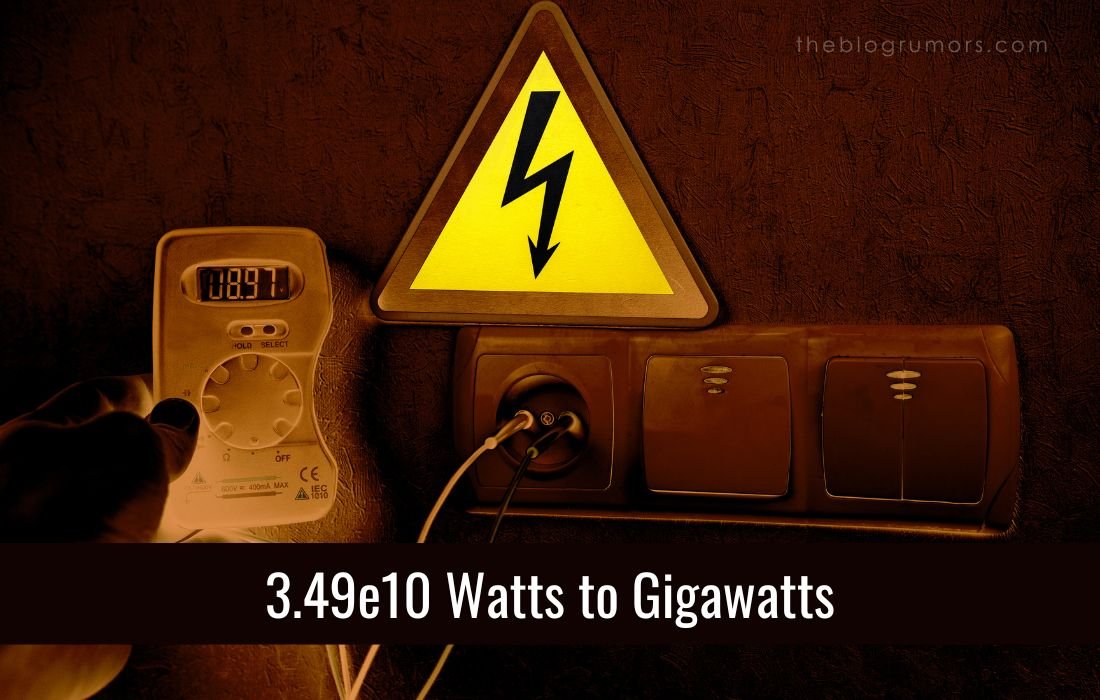Have you ever wondered how to translate a large power measurement that is written in scientific notation into more recognizable units? In disciplines like engineering, physics, and energy production, an understanding of these transformations is essential. The conversion of 3.49–10 watts to gigawatts, a unit frequently used for large-scale power generation, is covered in this article. Gaining proficiency in this conversion will help you understand the scope of power generation and consumption in contemporary life. This tutorial will provide you the skills you need to confidently analyze and discuss power measures, regardless of whether you’re a professional, student, or just interested in energy metrics.
Understanding Watts, Kilowatts, Megawatts, and Gigawatts
Knowing the various units of measurement and how they relate to one another is essential when working with enormous amounts of power, such as 3.49e10 watts to gigawatts. To get a better understanding, let’s dissect these power units.
Watts: The Fundamental Unit
The International System of Units (SI) uses watts (W) as the fundamental unit of power. This measurement, which bears James Watt’s name, quantifies the speed at which work is completed or energy is transported. One joule of energy per second is equivalent to one watt.
Scaling Up: Kilowatts and Megawatts
We come across megawatts (MW) and kilowatts (kW) when we proceed to larger power measurements:
- 1,000 watts equals 1 kilowatt
- One megawatt is equivalent to one million watts, or 1,000 kilowatts.
Common uses for these units include industrial applications, small-scale power generating, and home appliances.
Gigawatts: Powering on a Massive Scale
An even greater scale of power is represented by gigawatts (GW):
One gigawatt is equivalent to 1,000 megawatts or 1,000,000,000 watts.
When talking about enormous electrical grids, regional energy usage, or large power plants, this unit is frequently employed. We’re dealing with a significant quantity of power when converting 3.49 to 10 watts to gigawatts, therefore this larger unit is necessary for realistic representation.
Accurately analyzing and presenting large-scale energy measurements, like the conversion from 3.49e10 watts to gigawatts, requires an understanding of these power units and their relationships.
What is 3.49e10 Watts?
A very big amount of power is represented by the scientific notation 3.49e10 watts. Let’s dissect this enormous number and examine its relevance in relation to energy generation and consumption in order to put it into perspective.
Understanding Scientific Notation
Scientific notation is a way of expressing very large or very small numbers using powers of 10. In the case of 3.49e10 watts, it can be expanded to 34,900,000,000 watts or 34.9 billion watts. This method of notation is particularly useful when dealing with astronomical figures or microscopic measurements.
Contextualizing 3.49e10 Watts
When dealing with such large power values, it’s often more convenient to express them in gigawatts. One gigawatt is equal to one billion watts. To convert 3.49e10 watts to gigawatts, we simply divide by 1 billion:
3.49e10 watts ÷ 1,000,000,000 = 34.9 gigawatts
This conversion helps simplify the number while maintaining its impressive scale. The process of converting 3.49e10 watts to gigawatts allows for easier comparison with other large-scale power measurements, such as the output of major power plants or the energy consumption of entire cities.
Converting Watts to Kilowatts
Understanding the Basics
Before tackling the conversion of 3.49e10 watts to gigawatts, it’s crucial to understand the relationship between watts and kilowatts. A watt is the standard unit of power in the International System of Units (SI). It measures the rate at which energy is transferred or consumed. One kilowatt is equal to 1,000 watts, making it a more convenient unit for expressing larger amounts of power.
To convert watts to kilowatts, you simply divide the number of watts by 1,000. For example, 5,000 watts is equivalent to 5 kilowatts (5,000 ÷ 1,000 = 5).
Scaling Up: From Kilowatts to Gigawatts
When dealing with extremely large power values, such as 3.49e10 watts, we need to scale up even further. A gigawatt is equal to one billion watts or one million kilowatts. This unit is often used to measure the output of large power plants or the energy consumption of entire cities.
To convert from watts to gigawatts, you divide the number of watts by 1,000,000,000. In the case of 3.49e10 watts to gigawatts, we’re dealing with scientific notation, which represents very large numbers in a compact form.
Performing the Conversion
To convert 3.49e10 watts to gigawatts:
- Recognize that 3.49e10 is equivalent to 34,900,000,000 watts
- Divide this number by 1,000,000,000 (one billion)
- The result is 34.9 gigawatts
This conversion helps put into perspective the enormous amount of power represented by 3.49e10 watts. For context, a typical nuclear power plant might have an output of around 1 gigawatt, so 34.9 gigawatts is a substantial amount of power indeed.
Converting Kilowatts to Megawatts
Understanding Power Units
When dealing with large-scale energy conversions, such as 3.49e10 watts to gigawatts, it’s crucial to understand the relationship between different power units. Kilowatts (kW) and megawatts (MW) are commonly used in energy discussions, serving as stepping stones to comprehend larger units like gigawatts (GW).
The Conversion Process
To convert kilowatts to megawatts, you’ll need to divide the kilowatt value by 1,000. This is because one megawatt is equivalent to 1,000 kilowatts. For example:
- 1,000 kW = 1 MW
- 5,000 kW = 5 MW
- 10,000 kW = 10 MW
This conversion is essential when scaling up to larger units like gigawatts, which are often used to measure the output of power plants or the energy consumption of entire cities.
Practical Applications
For a number of purposes, knowing the difference between kilowatts and megawatts is essential:
- Measurement of power plant output
- Management of the energy grid
- Large-scale energy use in industry
- Project planning for renewable energy
Gaining proficiency in these conversions can help you work with and analyze energy data on a variety of scales, including 3.49e10 watts to gigawatts. This information serves as the basis for comprehending increasingly intricate energy comparisons and computations in industrial and environmental settings.
Converting Megawatts to Gigawatts
Knowing how to convert between multiple units is essential when working with large-scale power measurements. Megawatts (MW) to gigawatts (GW) is a frequently used conversion that is especially pertinent when talking about power outputs ranging from 3.49 to 10 watts.
Understanding the Basics
The main distinction between megawatts and gigawatts, which are both used to measure power, is their scale. Millions of watts is equal to a megawatt, and one billion watts is equal to a gigawatt. Accordingly, 1,000 megawatts is equivalent to one gigawatt.
The Conversion Process
All you have to do is divide the megawatts by 1,000 to convert them to gigawatts. For instance:
- 1,000 MW is equal to 1 GW.
- 5 GW is equal to 5,000 MW.
- 10 GW = 10,000 MW
Breaking down the conversion step-by-step is useful when working with really big quantities, such 3.49e10 watts to gigawatts:
- First, divide watts by one million to convert them to megawatts.
- Next, divide the resultant megawatts by 1,000 to convert them to gigawatts.
Practical Applications
It is crucial to comprehend this conversion in a number of domains, such as:
- Production and distribution of energy
- Evaluations of the effects on the environment
- Planning economically for power infrastructure
You’ll be more prepared to understand and talk about large-scale power measurements, such as situations involving 3.49e10 watts to gigawatts, if you can convert megawatts to gigawatts.
Step-by-Step: Converting 3.49e10 Watts to Gigawatts
The technique of converting 3.49 to 10 watts to gigawatts is simple and requires knowledge of unit conversion and scientific notation. To make the computation easier, let’s divide it into manageable chunks.
Understanding Scientific Notation
First, let’s figure out what “3.49e10 watts” means. “e10” is the symbol for 10 raised to the power of 10 in scientific notation. Thus, 3.49 × 10^10 watts, or 34,900,000,000 watts, is equal to 3.49 e10 watts.
The Conversion Factor
We must understand the link between watts and gigawatts in order to convert them:
One gigawatt is equivalent to 1,000,000,000 watts (10^9 watts).
For our computation, this conversion factor is essential.
Performing the Conversion
Let’s now translate 3.49 to 10 watts to gigawatts:
- In standard form, express 3.49e10 watts as follows: 34,900 million watts
- The conversion factor is divided by 34,900,000,000 ÷ 1,000,000,000.
- 34.9 gigawatts is the end outcome.
Consequently, 34.9 gigawatts is equal to 3.49e10 watts.
Verifying the Result
We can reverse the procedure to verify our conversion one more time:
34,900,000,000 watts are equal to 34.9 gigawatts × 1,000,000,000 watts/gigawatt.
This validates the accuracy of our conversion since it matches our initial number of 3.49e10 watts.
You can easily convert 3.49 to 10 watts to gigawatts or make comparable conversions between watts and other power units by following these steps. Recall that the secret to becoming proficient in these computations is to comprehend scientific notation and be aware of the appropriate conversion factors.

Real-World Examples and Applications
Power Generation and Distribution
It becomes especially important to convert 3.49e10 watts to gigawatts when talking about large-scale energy generation. This enormous power output, or 34.9 gigawatts, is similar to the combined output of several nuclear power reactors. To put things in perspective, a normal nuclear reactor produces about 1 gigawatt of electricity, therefore 3.49 to 10 watts is the capacity of over 35 of these reactors.
Renewable Energy Projects
Initiatives seeking to capture 3.49–10 watts would be regarded as enormous endeavours in the field of renewable energy. The Bhadla Solar Park in India, for example, is the largest solar farm in the world, with a capacity of over 2.25 gigawatts. In order to reach 34.9 gigawatts (3.49e10 watts to gigawatts), more than 15 of these facilities would be required. The magnitude of the energy problem we face is demonstrated by this comparison, which also emphasizes the potential and difficulties associated with switching to clean energy sources.
Industrial and Technological Applications
Beyond power generation, putting energy consumption in different industries into perspective is made easier by knowing the magnitude of 3.49 to 10 watts. Large data centres, for instance, can need hundreds of megawatts of electricity. An estimated 200–250 terawatt-hours of energy are used annually by all data centres worldwide. An understanding of the massive energy requirements of our digital infrastructure can be gained by converting 3.49–10 watts to gigawatts and taking into account its continuous output throughout time.
Also Read More: Exploring the filtro de aire k0r-tec1444
Common Mistakes to Avoid When Converting Watts to Gigawatts
It’s important to be mindful of various problems that could result in erroneous results when converting 3.49 to 10 watts to gigawatts. Here are some typical errors to steer clear of:
Misinterpreting Scientific Notation
Among the most common mistakes made when working with scientific notation is this one. 3.49 × 10^10 watts is what the term “3.49e10 watts” stands for. Ignoring this could lead to a serious calculation error. Before starting the conversion, make sure you’re correctly interpreting the notation.
Overlooking Unit Prefixes
Confusion over the prefixes used in metric units is another error. Keep in mind that:
- 1,000,000,000 watts is equal to one gigawatt.
- One gigawatt is one × 10^9 watts.
Using prefixes like “mega” or “tera” interchangeably with “giga” can result in mistakes that are 1,000 times or more wrong.
Rounding Too Early
Steer clear of hastily rounding intermediate values when converting 3.49–10 watts to gigawatts. To ensure accuracy, round only the final answer and carry all decimal places through your calculations.
Forgetting to Check Your Work
Always use alternative techniques or reverse calculations to verify your conversion. For example, to guarantee consistency, try converting the value back to watts after converting it to gigawatts.
Neglecting Context
Even though the mathematical conversion is simple, the measurement’s context must be taken into account. Understanding the scope and ramifications of gigawatt measurements is essential for meaningful interpretation in real-world applications, such as power plant production or energy consumption.
You can guarantee correct watt-to-gigawatt conversions and provide trustworthy data for a range of scientific, technical, and energy-related applications by avoiding these typical errors.
49e10 Watts to Gigawatts FAQ
What is the conversion of 3.49e10 watts to gigawatts?
You must comprehend the relationship between 3.49 and 10 watts in order to convert them to gigawatts. One gigawatt is equivalent to 1,000,000,000 watts, or one billion watts. Therefore, all you have to do is divide 3.49e10 watts by 1 billion to convert them to gigawatts.
The following is the calculation: 3.49 gigawatts, or 3.49e10 watts ÷ 1,000,000,000
Therefore, 34.9 gigawatts is equal to 3.49 e10 watts.
Why is this conversion important?
It is essential to comprehend the conversion from 3.49 to 10 watts to gigawatts in a number of domains, such as scientific research, power engineering, and energy production. Gigawatts are frequently used to quantify the energy consumption of entire cities or the output of massive power facilities. Massive power quantities can be more easily compared and understood thanks to this conversion.
How does 34.9 gigawatts compare to real-world power usage?
Think about these analogies to get a sense of 34.9 gigawatts:
- Approximately one gigawatt of electricity is produced by a conventional nuclear power plant.
- Approximately 10,715 kilowatt-hours, or 0.00122 gigawatts, are used annually by the typical American home.
- In 2020, there were roughly 743 gigawatts of wind power installed globally.
This provides a realistic example of the enormous magnitude of 3.49e10 watts, or 34.9 gigawatts.
Conclusion
To sum up, knowing how to convert 3.49 to 10 watts to gigawatts is an important ability in the field of energy analysis and measurement. You can quickly translate between these power units by using the straightforward conversion procedure described in this article. Once you understand that 1 gigawatt is equal to 1 billion watts, the conversion will be simple. Gaining proficiency in these conversions can improve your capacity to work with large-scale power measurements, regardless of your background—student, engineer, or energy professional.
Also Read More: Exploring rizuea4727 Vore Game





